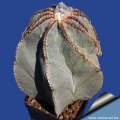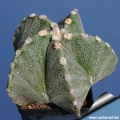




Your support is critical to our success.
Accepted Scientific Name: Astrophytum myriostigma Lem.
Cact. Gen. Sp. Nov. 4 (-6). 1839 [Feb 1839] Lem.
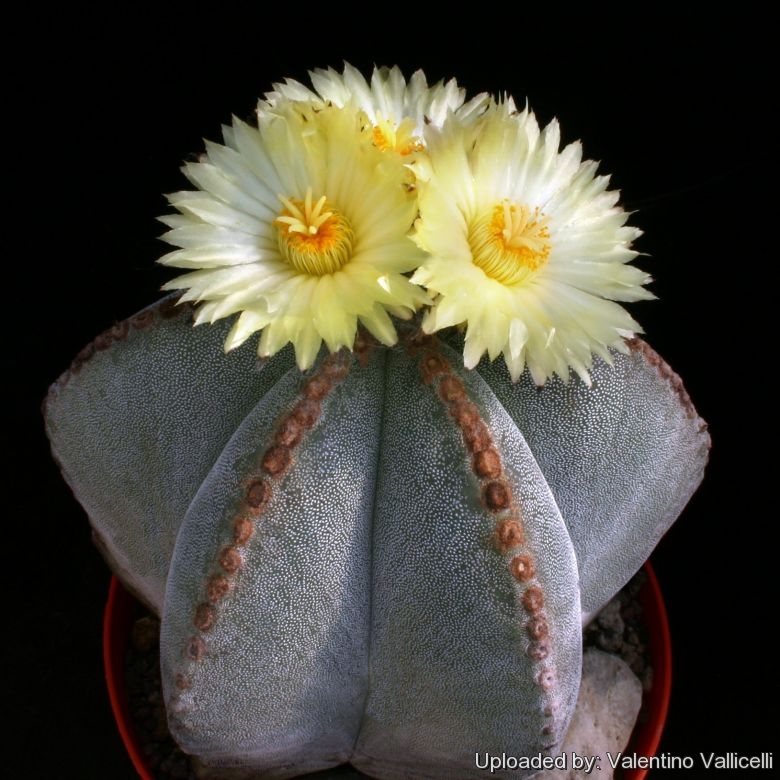
The name Astrophytum comes from the Greek word for star plant. These beautiful plants are globe shaped and are speckled with white scales and flecks. As it ages, the plant becomes columnar.
Origin and Habitat: Highlands of central and northern Mexico (states of Nuevo León, San Luis Potosí and Tamaulipas).
Altitude: It grows at elevations ranging from 750 to 1500 metres above sea level.
Habitat and Ecology: It grows on stony, calcareous soils on scrubby alluvial plains on steep, east or west (and southwest) facing slopes, and prefers low densities. It is also found in thin layers in the foothills of mountain ranges. Its distribution is limited by its need for stony, calcareous or lime soils. This calcicole also needs carbonates to integrate calcium and make itself more rigid. This species is found in habitat dominated by Agave lecheguilla, which acts as the main nurse plant to A. myriostigma. This species has a wide range and is extremely abundant, but extraction of individuals from natural populations and destruction of habitat from mining activities can threat the species. The habitat is also overgrazed by livestock (goats and cattle), and some subpopulations have been impacted by the building of roads. The same area harbour a rich succulent flora comprising: Gymnocactus viereckiiSN|14962]]SN|14962]], Neolloydia conoideaSN|10089]]SN|10089]], Mammillaria candidaSN|25913]]SN|9015]], Mammillaria klissingianaSN|9015]]SN|25913]], Obregonia denegriiSN|2100]]SN|2100]], Thelocactus hexaedrophorusSN|10830]]SN|10830]], Turbinicarpus lophophoroidesSN|11693]]SN|11693]], Ariocarpus retususSN|2079]]SN|2079]], Coryphantha maiz-tablasensisSN|10267]]SN|10267]], Ferocactus echidneSN|1690]]SN|1690]], Echinocereus blanckiiSN|7478]]SN|7478]], Echinocactus ingensSN|10372]]SN|10372]] and Opuntia microdasysSN|15506]]SN|15506]].
Synonyms:
- Astrophytum myriostigma Lem.
- Astrophytum prismaticum Lem.
- Cereus callicoche Galeotti ex Scheidw.
- Echinocactus myriostigma (Lem.) Salm-Dyck
Astrophytum myriostigma Lem.
Cact. Gen. Sp. Nov. 4 (-6). 1839 [Feb 1839]
Synonymy: 68
- Astrophytum myriostigma Lem.
- Astrophytum prismaticum Lem.
- Cereus callicoche Galeotti ex Scheidw.
- Echinocactus myriostigma (Lem.) Salm-Dyck
- Astrophytum myriostigma f. aurata hort.
- Astrophytum myriostigma f. aurea Gräser
- Astrophytum myriostigma var. bicostatum hort.
- Astrophytum myriostigma var. caespitosum Y.Itô
- Astrophytum myriostigma var. cereiforme Frič
- Astrophytum myriostigma var. columare-octogonum Y.Itô
- Astrophytum myriostigma var. columnare Frič
- Astrophytum columnare (K.Schum.) Sadovsky & Schütz in Sadovsky & Schütz
- Astrophytum myriostigma var. columnare (Schum.) Tsuda
- Echinocactus myriostigma var. columnaris K.Schum.
- Echinocactus myriostigma f. columnaris (K.Schum.) Schelle
- Astrophytum myriostigma f. cristatum (hort.) Y.Itô
- Astrophytum myriostigma cv. Cristata Tony Sato
- Astrophytum myriostigma var. depressa Megata
- Astrophytum myriostigma var. globescens T.Ishikawa
- Astrophytum myriostigma var. grandiflorum Frič
- Astrophytum myriostigma var. hexagona W.Mastrangel
- Astrophytum myriostigma var. minimiflorum Frič
- Astrophytum myriostigma mirbella, H.Lewis
- Astrophytum myriostigma var. nudicarpa Frič
- Astrophytum myriostigma var. nudum (Rud.Mey.) Megata
- Astrophytum myriostigma subs. glabrum Backeb.
- Astrophytum myriostigma subvar. nudum (Rud.Mey.) Backeb.
- Astrophytum myriostigma cv. Hekiran
- Echinocactus myriostigma var. nudus Rud.Mey.
- Astrophytum myriostigma var. nudum f. colorata hort.
- Astrophytum myriostigma var. nudum f. cristatum hort.
- Astrophytum myriostigma var. nudum f. picta hort.
- Astrophytum myriostigma var. nudum f. variegatum hort.
- Astrophytum myriostigma var. nudum-octogonum Y.Itô
- Astrophytum myriostigma var. nudum-pubesente Y.Itô
- Astrophytum myriostigma f. picta hort.
- Astrophytum myriostigma var. potosinum (K.Kayser) Borg
- Astrophytum myriostigma subs. potosinum K.Kayser
- Echinocactus myriostigma subs. potosinus (Kanfer) H.Moeller
- Astrophytum myriostigma f. proliferum hort.
- Astrophytum myriostigma var. quadricostatum (H.Moeller) Borg
- Astrophytum myriostigma subs. quadricostatum (H.Moeller) Kanfer
- Astrophytum myriostigma var. quadricostatum-pubesente Y.Itô
- Astrophytum quadratum Cobbold in Walton
- Echinocactus myriostigma subs. quadricostatus H.Moeller
- Echinocactus myriostigma var. quadricostatus H.Moeller
- Echinocactus myriostigma var. quadricostatus H.Moeller
- Astrophytum myriostigma var. quadricostatum f. nudum hort.
- Astrophytum myriostigma var. strongylogonum Backeb.
- Astrophytum myriostigma var. tamaulipense (Kanfer) W.T.Marshall
- Astrophytum myriostigma var. tricostatum hort.
- Astrophytum myriostigma f. tricostatum H.Hirao
- Astrophytum myriostigma cv. Sankaku Ranpo-gyoku
- Astrophytum myriostigma cv. Trescostatum Tony Sato
- Astrophytum myriostigma var. tricostatum f. nudum variegatum hort.
- Astrophytum myriostigma var. tricostatum f. nudum hort.
- Astrophytum myriostigma var. tricostatum f. proliferum hort.
- Astrophytum myriostigma f. trunco variegato Gräser
- Astrophytum myriostigma var. tulense (K.Kayser) Y.Itô
- Astrophytum myriostigma subs. tulense K.Kayser
- Astrophytum tulense (K.Kayser) Sadovsky & Schütz in Sadovsky & Schütz
- Astrophytum myriostigma f. variegatum T.Ishikawa
- Astrophytum myriostigma cv. Variegata Tony Sato
- Astrophytum myriostigma var. verum W.T.Marshall
- Astrophytum stellata, Lawr.
Astrophytum myriostigma f. rubra hort.
Synonymy: 2
- Astrophytum myriostigma f. rubra hort.
- Astrophytum myriostigma ''polycephala''
- Astrophytum myriostigma cv. multicostatum Tony Sato
- Astrophytum myriostigma f. multicostatum Tony Sato
- Astrophytum myriostigma cv. Multipunctatum Tony Sato
- Astrophytum myriostigma var. nudum cv. Maiden's Blush
- Astrophytum myriostigma var. strongylogonum f. nudum cv. Costa
- Astrophytum myriostigma cv. Costa Tony Sato
- Astrophytum myriostigma cv. Abekobe
- Astrophytum myriostigma cv. Anceps Tony Sato
- Astrophytum myriostigma cv. Ball
- Astrophytum myriostigma cv. Ball nudum Ligthtnig
- Astrophytum myriostigma cv. Biyatsuko Tony Sato
- Astrophytum myriostigma cv. Curveline Tony Sato
- Astrophytum myriostigma cv. Double Ribs Nudum
- Astrophytum myriostigma cv. Double Ribs Nudum cristata
- Astrophytum myriostigma cv. Dragon
- Astrophytum myriostigma cv. Dragon Hekiran
- Astrophytum myriostigma cv. Ekubo Tony Sato
- Astrophytum myriostigma cv. Fire Works
- Astrophytum myriostigma cv. Fjordhest
- Astrophytum myriostigma var. fjordherst, Sadovsky & Schütz
- Astrophytum myriostigma f. nuda Fjordhest Gräser
- Astrophytum myriostigma cv. Fukuryu (type A)
- Astrophytum myriostigma cv. Fukuryu (type A) tricostatum
- Astrophytum myriostigma cv. Fukuryu (type B)
- Astrophytum myriostigma cv. Fucuriyo Tony Sato
- Astrophytum myriostigma cv. Fukuryu (type B) nudum
- Astrophytum myriostigma cv. Fukuryu (type B) nudum variegatum
- Astrophytum myriostigma cv. Fukuryu (type B) tricostatum
- Astrophytum myriostigma cv. Fukuryu (type B) variegatum
- Astrophytum myriostigma cv. Fukuryu reticulatus
- Astrophytum myriostigma cv. Ginsiya Tony Sato
- Astrophytum myriostigma cv. Hakujo
- Astrophytum myriostigma cv. Hakujo Fukuryu
- Astrophytum myriostigma cv. Hakujo Fukuryu cristatum
- Astrophytum myriostigma cv. Hakujo Hakuun
- Astrophytum myriostigma cv. Hakuun Tony Sato
- Astrophytum myriostigma cv. Hakuun Ball Form
- Astrophytum myriostigma cv. Hakuun Fukuryu
- Astrophytum myriostigma cv. Hakuun nudum
- Astrophytum myriostigma cv. Hakuun nudum cristatum (Thick form)
- Astrophytum myriostigma cv. Hakuun nudum cristatum (Thin form)
- Astrophytum myriostigma cv. Hakuun nudum cristatum variegatum
- Astrophytum myriostigma cv. Hakuun tricostatum
- Astrophytum myriostigma cv. Hanakago Tony Sato
- Astrophytum myriostigma cv. Hanakago Hakuun
- Astrophytum myriostigma cv. Huboki
- Astrophytum myriostigma cv. Hubuki
- Astrophytum myriostigma cv. Irregular Ribs
- Astrophytum myriostigma cv. Karina Keel Crested Fukuryu
- Astrophytum myriostigma cv. Kikko
- Astrophytum myriostigma cv. Kitsukou Tony Sato
- Astrophytum myriostigma cv. Kikko Alien
- Astrophytum myriostigma cv. Kikko Ball
- Astrophytum myriostigma cv. Kikko Ball nudum
- Astrophytum myriostigma cv. Kikko f. rubra
- Astrophytum myriostigma cv. Kikko Fukuryiu
- Astrophytum myriostigma cv. Kikko Hakuun
- Astrophytum myriostigma cv. Kikko nudum
- Astrophytum myriostigma cv. Kikko nudum f. cristata
- Astrophytum myriostigma cv. Kikko nudum f. variegata
- Astrophytum myriostigma cv. Kikko nudum fa.
- Astrophytum myriostigma cv. Kikko nudum Koh-yo
- Astrophytum myriostigma cv. Kikko quadricostatum
- Astrophytum myriostigma cv. Kikko Swarovski
- Astrophytum myriostigma cv. Koh-yo
- Astrophytum myriostigma cv. Koh-yo f. cristata
- Astrophytum myriostigma cv. Laimake
- Astrophytum myriostigma cv. Lin Pin Gata Tony Sato
- Astrophytum myriostigma cv. Line Areole Tony Sato
- Astrophytum myriostigma cv. Lotusland
- Astrophytum myriostigma cv. Maculatum cristatum
- Astrophytum myriostigma cv. Milky Way Tony Sato
- Astrophytum myriostigma cv. Mini Tony Sato
- Astrophytum myriostigma cv. Monstrosa Tony Sato
- Astrophytum myriostigma cv. Mottles Tony Sato
- Astrophytum myriostigma cv. Onzuka Tony Sato
- Astrophytum myriostigma cv. Onzuka Blind form
- Astrophytum myriostigma cv. Blind
- Astrophytum myriostigma cv. Onzuka columnare
- Astrophytum myriostigma cv. Onzuka cristata
- Astrophytum myriostigma cv. Onzuka cristata (monstruosa)
- Astrophytum myriostigma cv. Onzuka Fukuryu
- Astrophytum myriostigma cv. Onzuka Fukuryu tricostatum
- Astrophytum myriostigma cv. Onzuka Hakuun
- Astrophytum myriostigma cv. Onzuka Kikko
- Astrophytum myriostigma cv. Onzuka Kikko Ball
- Astrophytum myriostigma cv. Onzuka Line Areoles
- Astrophytum myriostigma cv. Onzuka quadricostatum
- Astrophytum myriostigma cv. Onzuka tricostatum
- Astrophytum myriostigma cv. Onzuka tricostatum columnare
- Astrophytum myriostigma cv. Onzuka V-Type
- Astrophytum myriostigma cv. Ooibo
- Astrophytum myriostigma cv. Big Areole Tony Sato
- Astrophytum myriostigma cv. Ooibo nudum
- Astrophytum myriostigma cv. Rank With Tony Sato
- Astrophytum myriostigma cv. Rensei
- Astrophytum myriostigma cv. Riyukotsu Tony Sato
- Astrophytum myriostigma cv. Red Tony Sato
- Astrophytum myriostigma cv. Rubriflora Tony Sato
- Astrophytum myriostigma cv. Sazanami
- Astrophytum myriostigma cv. Seiji
- Astrophytum myriostigma cv. Small Areole Tony Sato
- Astrophytum myriostigma cv. Spiral Ribs
- Astrophytum myriostigma cv. Spirale Tony Sato
- Astrophytum myriostigma cv. Suminagashi
- Astrophytum myriostigma cv. Tetsusabi
- Astrophytum myriostigma cv. Thin Tony Sato
- Astrophytum myriostigma cv. Yaribusana
- Astrophytum myriostigma cv. Yoroi
ENGLISH: Bishop's Cap, Bishop's Miter, Bishop's hat, Monk's Hood, Deacons Hat, Bishop's Hood, Miter Cactus
ARABIC ( لعربية ): أستروفيتم ميروستيجيما
CHINESE (中文): 鸾凤玉, 鸾凤玉(四棱), 鸾凤玉(龙凤), 碧琉璃(红叶), 优选碧方玉, 白云恩塚鸾凤玉, 鸾凤玉(变锦), 红叶锦(黄), 红叶锦}{碧琉璃鸾凤玉(多头), 恩塚丸棱四角鸾凤玉}{鸾凤玉(多头), 恩塚丸棱鸾凤玉, 恩塚}{恩塚(杂交变种), 龟甲鸾凤玉(稍红}, 三角鸾凤玉
CROATIAN (Hrvatski): Zvjezdasti kaktusi
DUTCH (Nederlands): Bisschopsmuts, Sterplanten
FRENCH (Français): Plante étoile
GERMAN (Deutsch): Zahllospunctirter Igelcactus, Punkt-Sterncactus, Mitra, Bischofsmütze Kaktus, Bischofsmütze
HUNGARIAN (Magyar): Csillagkaktusz
ITALIAN (Italiano): Cappello del Vescovo, Cappello del Prete, Berretta da Prete
JAPANESE (日本語): Rampo, アストロフィトゥム, Rampow
LITHUANIAN (Lietuvių): Žvaigždinas
MASRY (مصرى): استروفياتوم
SPANISH (Español): Gajitos, Mitra, Bonete de Obispo, Peyotillo, Peyote Cimarron, Biznaga, Algononcillo de Mitra, Birrete de Obispo, Planta estrella
SWEDISH (Svenska): Biskopsmössa kaktus, Biskopskaktus, Biskopsmössa
TARAHUMARA: Híkuri cimarrón
Description: Astrophytum myriostigmaSN|1845]]SN|1845]] (many dotted) is a spineless succulent plant, usually solitary or with very few basal branches. A transverse section of the stem reveal a perfect star shaped form (like the common star-fish) giving the plant the appearance of a bishop's mitre (hence the common name Bishop's cap)
Stem: Globular to cylindric up to 60(-100) cm tall (but occasionally up 150 cm tall) and 10-20 cm in diameter, bright green, covered with many minute white hairy scales that give it a characteristic chalk-white or silvery-grey appearance, but sometime naked. The scales are composed of very fine interwoven hairs, which, under a microscope, are very pretty object.
Roots: Fine, fibrous.
Areoles: Closed together
Spines: Wanting.
Ribs: Usually 5, sometimes 4(or 3) that increase to eight or more with age ( rarely even 10), vertical, regular, deep, prominent, very broad and acute.
Flowers: Funnelform, 4-7 cm long glossy yellow and sweet scented from the areole at the tip of the stem on mature plant. Outer perianth segments narrow, with brown scarious tips. Inner perianth segments numerous, oblong yellow with a silky shine. Scales on ovary tube scaroious, imbricated, very narrow often bristly tipped, with long wool in their axil.
Blooming season: A. myriostigma seems to flower independently of day length, flowering asynchronously and intermittently throughout the warm months from the end of winter to the start of autumn. Plants may take up to six years to flower.
Fruit: 2-2,5 cm in diameter, greenish to tannish-red, covered with brown, overlapping scales, with long wool in their axil.
Seeds: Dark brown, helmet-shaped, shining, with a large depressed hilum, the margins being turned in.
Subspecies, varieties, forms and cultivars of plants belonging to the Astrophytum myriostigma group
 Astrophytum myriostigma Lem.: It is a spineless solitary plant covered with many white dots. A transverse section of the stem reveal a perfect 5 pointed star shaped form (like the common star-fish) giving the plant the appearance of a bishop's mitre (hence the common name Bishop's cap)
Astrophytum myriostigma Lem.: It is a spineless solitary plant covered with many white dots. A transverse section of the stem reveal a perfect 5 pointed star shaped form (like the common star-fish) giving the plant the appearance of a bishop's mitre (hence the common name Bishop's cap) Astrophytum myriostigma var. bicostatum hort.: has only two ribs. It is indeed quite unstable and rarely maintains the rare characteristic for many years.
Astrophytum myriostigma var. bicostatum hort.: has only two ribs. It is indeed quite unstable and rarely maintains the rare characteristic for many years. Astrophytum myriostigma var. columnare Frič: has a more columnar growth and smaller flowers size.
Astrophytum myriostigma var. columnare Frič: has a more columnar growth and smaller flowers size. Astrophytum myriostigma f. cristatum (hort.) Y.Itô: crested form. There are several crested forms mainly selected by Asian growers.
Astrophytum myriostigma f. cristatum (hort.) Y.Itô: crested form. There are several crested forms mainly selected by Asian growers. Astrophytum myriostigma var. nudum (Rud.Mey.) Megata: deviate from the well-known typical form for lacking white flecks, giving a bright green, blue-green or mauve-green color overall depending on clones.
Astrophytum myriostigma var. nudum (Rud.Mey.) Megata: deviate from the well-known typical form for lacking white flecks, giving a bright green, blue-green or mauve-green color overall depending on clones. Astrophytum myriostigma var. nudum f. colorata hort.: has yellow, orange or red stems due to the absence (or reduced production) of chlorophyll pigments.
Astrophytum myriostigma var. nudum f. colorata hort.: has yellow, orange or red stems due to the absence (or reduced production) of chlorophyll pigments. Astrophytum myriostigma var. nudum f. cristatum hort.: has fan shaped stems, smooth, glossy green, blue-green, grey-green or mauve-green, thin or thick (depending on clone).
Astrophytum myriostigma var. nudum f. cristatum hort.: has fan shaped stems, smooth, glossy green, blue-green, grey-green or mauve-green, thin or thick (depending on clone).  Astrophytum myriostigma var. nudum f. picta hort.: has stem variegated with yellow, orange or red. The pictured forms are very attractive and highly prized.
Astrophytum myriostigma var. nudum f. picta hort.: has stem variegated with yellow, orange or red. The pictured forms are very attractive and highly prized. Astrophytum myriostigma var. nudum f. variegatum hort.: has sectors, patches or stripes with distinct shades of yellow or orange.
Astrophytum myriostigma var. nudum f. variegatum hort.: has sectors, patches or stripes with distinct shades of yellow or orange. Astrophytum myriostigma var. nudum cv. Maiden's Blush: differs from the standard "nudum" for its mauve-green color overall and shine epidermis.
Astrophytum myriostigma var. nudum cv. Maiden's Blush: differs from the standard "nudum" for its mauve-green color overall and shine epidermis. Astrophytum myriostigma f. picta hort.: has stem variegated with yellow, orange, red and violet. These pictured plants are very attractive and highly prized.
Astrophytum myriostigma f. picta hort.: has stem variegated with yellow, orange, red and violet. These pictured plants are very attractive and highly prized.- Astrophytum myriostigma var. potosinum (K.Kayser) Borg
- Astrophytum myriostigma f. proliferum hort.: has an abnormal tendency to branch forming small side pups from the areole. In cultivation there are several clones some of them branching like mad, while other almost normal.
 Astrophytum myriostigma var. quadricostatum (H.Moeller) Borg: This form deviates from the well-known typical form for having four ribs instead of five.
Astrophytum myriostigma var. quadricostatum (H.Moeller) Borg: This form deviates from the well-known typical form for having four ribs instead of five. Astrophytum myriostigma var. quadricostatum f. nudum hort.: (cv. Hekiho-gyoku) has only 4 ribs lacking white flecks, giving a bright green, blue-green or mauve-green color overall depending on clones.
Astrophytum myriostigma var. quadricostatum f. nudum hort.: (cv. Hekiho-gyoku) has only 4 ribs lacking white flecks, giving a bright green, blue-green or mauve-green color overall depending on clones. Astrophytum myriostigma f. rubra hort.: has notches ribs of a bright orange-red colout due to the absence (or reduced production) of chlorophyll pigments.
Astrophytum myriostigma f. rubra hort.: has notches ribs of a bright orange-red colout due to the absence (or reduced production) of chlorophyll pigments. Astrophytum myriostigma var. strongylogonum Backeb.: differs from the other typical myriostigmas for the 5 fat ribs that are always rounded and noticeably curved.
Astrophytum myriostigma var. strongylogonum Backeb.: differs from the other typical myriostigmas for the 5 fat ribs that are always rounded and noticeably curved. Astrophytum myriostigma var. strongylogonum f. nudum cv. Costa: The plants are nude blue-grey and show wavy and corrugated surface.
Astrophytum myriostigma var. strongylogonum f. nudum cv. Costa: The plants are nude blue-grey and show wavy and corrugated surface.- Astrophytum myriostigma var. tamaulipense (Kanfer) W.T.Marshall
 Astrophytum myriostigma var. tricostatum hort.: (cv. Sankaku Ranpo-gyoku) has only three ribs with light or dense white flecks that cover the stem.
Astrophytum myriostigma var. tricostatum hort.: (cv. Sankaku Ranpo-gyoku) has only three ribs with light or dense white flecks that cover the stem. Astrophytum myriostigma var. tricostatum f. nudum variegatum hort.: has 3 ribs with sectors, patches or stripes with distinct shades of yellow or orange.
Astrophytum myriostigma var. tricostatum f. nudum variegatum hort.: has 3 ribs with sectors, patches or stripes with distinct shades of yellow or orange. Astrophytum myriostigma var. tricostatum f. nudum hort.: has only three ribs lacking or mostly lacking the white flecks giving it a bright green, blue-green, or mauve-green colour.
Astrophytum myriostigma var. tricostatum f. nudum hort.: has only three ribs lacking or mostly lacking the white flecks giving it a bright green, blue-green, or mauve-green colour. Astrophytum myriostigma var. tricostatum f. proliferum hort.: has only three ribs that forms small side pups from the areole. There are several clones some of them branching like mad, while other almost normal.
Astrophytum myriostigma var. tricostatum f. proliferum hort.: has only three ribs that forms small side pups from the areole. There are several clones some of them branching like mad, while other almost normal.  Astrophytum myriostigma var. tulense (K.Kayser) Y.Itô: has very columnar chalk-white stems up to 90 cm tall. Ribs 5 increasing to as many as 10 as the plant matures, vertical or twisted. Distribution:
Astrophytum myriostigma var. tulense (K.Kayser) Y.Itô: has very columnar chalk-white stems up to 90 cm tall. Ribs 5 increasing to as many as 10 as the plant matures, vertical or twisted. Distribution:  Astrophytum myriostigma f. variegatum T.Ishikawa: has sectors, patches or stripes with distinct shades of yellow or orange.
Astrophytum myriostigma f. variegatum T.Ishikawa: has sectors, patches or stripes with distinct shades of yellow or orange. - Astrophytum myriostigma var. verum W.T.Marshall
 Astrophytum myriostigma cv. Abekobe: has an chalky-white body, almost completely covered with white flocks.
Astrophytum myriostigma cv. Abekobe: has an chalky-white body, almost completely covered with white flocks.- Astrophytum myriostigma cv. Ball: has usually 5 ribs that are very fat and rounded (not acute).
 Astrophytum myriostigma cv. Ball nudum Ligthtnig: combines the characteristic radiating designs around each areole of Astrophytum myriostigma cv. Fire Works with the round ribbed stems of the the green "Ball" form.
Astrophytum myriostigma cv. Ball nudum Ligthtnig: combines the characteristic radiating designs around each areole of Astrophytum myriostigma cv. Fire Works with the round ribbed stems of the the green "Ball" form.  Astrophytum myriostigma cv. Double Ribs Nudum: its ribs forming two parallel lines of areoles on each crest.
Astrophytum myriostigma cv. Double Ribs Nudum: its ribs forming two parallel lines of areoles on each crest. Astrophytum myriostigma cv. Double Ribs Nudum cristata: crested form. It has two parallel lines of areoles on each rib.
Astrophytum myriostigma cv. Double Ribs Nudum cristata: crested form. It has two parallel lines of areoles on each rib. Astrophytum myriostigma cv. Dragon: has bulging, crest-like outgrowths between contiguous ribs. These crest-like outgrowths become more and more raised as the plant ages.
Astrophytum myriostigma cv. Dragon: has bulging, crest-like outgrowths between contiguous ribs. These crest-like outgrowths become more and more raised as the plant ages.- Astrophytum myriostigma cv. Dragon Hekiran: Is the nude form (green) of cv. Dragoon.
 Astrophytum myriostigma cv. Fire Works: has a very wrinkled appearance recalling the shape of an Aztekium ritteri with lovely firework designs radiating from each areole, hence the name.
Astrophytum myriostigma cv. Fire Works: has a very wrinkled appearance recalling the shape of an Aztekium ritteri with lovely firework designs radiating from each areole, hence the name.  Astrophytum myriostigma cv. Fjordhest: it lacks, or mostly lacks, white flecks. In adult specimens the brown areoles on the ribs becomes very close and form an unbroken line, a chain of areoles.
Astrophytum myriostigma cv. Fjordhest: it lacks, or mostly lacks, white flecks. In adult specimens the brown areoles on the ribs becomes very close and form an unbroken line, a chain of areoles.- Astrophytum myriostigma cv. Fukuryu (type A): has extra rib sandwiched between two contiguous true ribs. These additional ribs will not reach the plant apex and have not areoles. It is the more common form.
 Astrophytum myriostigma cv. Fukuryu (type A) tricostatum: It shows some interesting intermediate features of both cv. Fukuryu (type A) and var. tricostatum.
Astrophytum myriostigma cv. Fukuryu (type A) tricostatum: It shows some interesting intermediate features of both cv. Fukuryu (type A) and var. tricostatum. Astrophytum myriostigma cv. Fukuryu (type B): has many irregular (more or less prominent) “warts” between and on the ribs surface. This form is more rare.
Astrophytum myriostigma cv. Fukuryu (type B): has many irregular (more or less prominent) “warts” between and on the ribs surface. This form is more rare. Astrophytum myriostigma cv. Fukuryu (type B) nudum: Plants with many irregular (more or less prominent) “warts” between and on the ribs surface. Nude form (or with very few white dots)
Astrophytum myriostigma cv. Fukuryu (type B) nudum: Plants with many irregular (more or less prominent) “warts” between and on the ribs surface. Nude form (or with very few white dots) Astrophytum myriostigma cv. Fukuryu (type B) nudum variegatum: has many irregular (more or less prominent) “warts” between and on the ribs surface and has sectors, patches or stripes with distinct shades of yellow or orange.
Astrophytum myriostigma cv. Fukuryu (type B) nudum variegatum: has many irregular (more or less prominent) “warts” between and on the ribs surface and has sectors, patches or stripes with distinct shades of yellow or orange.- Astrophytum myriostigma cv. Fukuryu (type B) tricostatum
 Astrophytum myriostigma cv. Fukuryu (type B) variegatum
Astrophytum myriostigma cv. Fukuryu (type B) variegatum Astrophytum myriostigma cv. Fukuryu reticulatus: has small very thin, extra ribs each of them with a white felty line on it so it seems like the ribs are connected with each other.
Astrophytum myriostigma cv. Fukuryu reticulatus: has small very thin, extra ribs each of them with a white felty line on it so it seems like the ribs are connected with each other.- Astrophytum myriostigma cv. Hakujo: The woolly areoles on the ribs have a felty line between them so it seems like the areoles are connected with each other.
 Astrophytum myriostigma cv. Hakujo Fukuryu: has inherited by 'cv. Fukuryu' the felty line between contiguous areoles and by 'cv. Fukuryu' the many irregular (more or less prominent) “warts” between and on the ribs.
Astrophytum myriostigma cv. Hakujo Fukuryu: has inherited by 'cv. Fukuryu' the felty line between contiguous areoles and by 'cv. Fukuryu' the many irregular (more or less prominent) “warts” between and on the ribs. Astrophytum myriostigma cv. Hakujo Fukuryu cristatum: Crested form withs felty line between contiguous areoles and irregular “warts” between and on the ribs.
Astrophytum myriostigma cv. Hakujo Fukuryu cristatum: Crested form withs felty line between contiguous areoles and irregular “warts” between and on the ribs. Astrophytum myriostigma cv. Hakujo Hakuun: has inherited by 'cv. Fukuryu' the felty line between contiguous areoles and by 'cv. Hakuun' the many irregular white flecks that condense forming characteristic cloud-like patches.
Astrophytum myriostigma cv. Hakujo Hakuun: has inherited by 'cv. Fukuryu' the felty line between contiguous areoles and by 'cv. Hakuun' the many irregular white flecks that condense forming characteristic cloud-like patches. Astrophytum myriostigma cv. Hakuun Tony Sato: has white flecks that condense forming characteristic cloud-like patches.
Astrophytum myriostigma cv. Hakuun Tony Sato: has white flecks that condense forming characteristic cloud-like patches.  Astrophytum myriostigma cv. Hakuun Ball Form: has rounded stems with flecks forming characteristic cloud-like patches.
Astrophytum myriostigma cv. Hakuun Ball Form: has rounded stems with flecks forming characteristic cloud-like patches.  Astrophytum myriostigma cv. Hakuun Fukuryu: has many irregular (more or less prominent) “warts” between and on the ribs surface and has white flecks that condense forming characteristic cloud-like patches.
Astrophytum myriostigma cv. Hakuun Fukuryu: has many irregular (more or less prominent) “warts” between and on the ribs surface and has white flecks that condense forming characteristic cloud-like patches. Astrophytum myriostigma cv. Hakuun nudum: It is a nude plant with characteristic white cloud-like patches.
Astrophytum myriostigma cv. Hakuun nudum: It is a nude plant with characteristic white cloud-like patches. Astrophytum myriostigma cv. Hakuun nudum cristatum (Thick form): is a very nice crested cactus derived from the maculated form. The stem is smooth, glossy green, blue-green, grey-green or mauve-green with white cloud-like patches.
Astrophytum myriostigma cv. Hakuun nudum cristatum (Thick form): is a very nice crested cactus derived from the maculated form. The stem is smooth, glossy green, blue-green, grey-green or mauve-green with white cloud-like patches. Astrophytum myriostigma cv. Hakuun nudum cristatum (Thin form): is a thin crested variant of the maculated form. The stem is blue-green, grey-green or mauve-green with white cloud-like patches.
Astrophytum myriostigma cv. Hakuun nudum cristatum (Thin form): is a thin crested variant of the maculated form. The stem is blue-green, grey-green or mauve-green with white cloud-like patches. Astrophytum myriostigma cv. Hakuun nudum cristatum variegatum: has a characteristic maculated epidermis (with white cloud-like patches) The plant is the nude and variegated form with shining green and yellow epidermis.
Astrophytum myriostigma cv. Hakuun nudum cristatum variegatum: has a characteristic maculated epidermis (with white cloud-like patches) The plant is the nude and variegated form with shining green and yellow epidermis. Astrophytum myriostigma cv. Hakuun tricostatum: Differs from the typical A. myriostigma for the white flecks that condense forming characteristic cloud-like patches and for having three ribs instead of five.
Astrophytum myriostigma cv. Hakuun tricostatum: Differs from the typical A. myriostigma for the white flecks that condense forming characteristic cloud-like patches and for having three ribs instead of five. Astrophytum myriostigma cv. Hanakago Tony Sato: In Japan The name “hanakago” also refers to Aztekium ritteri. It is a nude plant with a wrinkled appearance, almost "crumpled" recalling an extreme form of cv. Fukuryu.
Astrophytum myriostigma cv. Hanakago Tony Sato: In Japan The name “hanakago” also refers to Aztekium ritteri. It is a nude plant with a wrinkled appearance, almost "crumpled" recalling an extreme form of cv. Fukuryu. Astrophytum myriostigma cv. Hanakago Hakuun: has very wrinkled, almost "crumpled" stems and recalling the shape of an Aztekium ritteri and spotted epidermis with white cloud-like patches.
Astrophytum myriostigma cv. Hanakago Hakuun: has very wrinkled, almost "crumpled" stems and recalling the shape of an Aztekium ritteri and spotted epidermis with white cloud-like patches. Astrophytum myriostigma cv. Huboki: The stems and lateral branches are finger like1,5-2,5 cm in diameter, up to12 cm tall. it has white dots that condense at evenly-spaced intervals on the epidermis forming a cloud like decorative design.
Astrophytum myriostigma cv. Huboki: The stems and lateral branches are finger like1,5-2,5 cm in diameter, up to12 cm tall. it has white dots that condense at evenly-spaced intervals on the epidermis forming a cloud like decorative design. Astrophytum myriostigma cv. Hubuki: The white dots of "HUBUKI " are usually spaced in a uniform manner, while on the contrary those of "HOBOKI" form white bands.
Astrophytum myriostigma cv. Hubuki: The white dots of "HUBUKI " are usually spaced in a uniform manner, while on the contrary those of "HOBOKI" form white bands. Astrophytum myriostigma cv. Irregular Ribs: has unusual irregular, broken or branched ribs.
Astrophytum myriostigma cv. Irregular Ribs: has unusual irregular, broken or branched ribs. Astrophytum myriostigma cv. Karina Keel Crested Fukuryu
Astrophytum myriostigma cv. Karina Keel Crested Fukuryu Astrophytum myriostigma cv. Kikko: has pointed tubercles along the ribs edges, in fact its areoles stick out with large notches between them, giving them a saw tooth look.
Astrophytum myriostigma cv. Kikko: has pointed tubercles along the ribs edges, in fact its areoles stick out with large notches between them, giving them a saw tooth look. Astrophytum myriostigma cv. Kikko Alien: is the only offsetting form of "Kikko nudum". Each tubercle develops a small rudimentary or well formed offset on the tip.
Astrophytum myriostigma cv. Kikko Alien: is the only offsetting form of "Kikko nudum". Each tubercle develops a small rudimentary or well formed offset on the tip.- Astrophytum myriostigma cv. Kikko Ball: has usually 5 ribs that are very fat and rounded (not acute) and the tubercles are not pointed too with the apical areole deeply sunken in the centre.
 Astrophytum myriostigma cv. Kikko Ball nudum: has nude dell green stems with 5 ribs that are very fat and rounded (not acute) and the tubercles are not pointed too.
Astrophytum myriostigma cv. Kikko Ball nudum: has nude dell green stems with 5 ribs that are very fat and rounded (not acute) and the tubercles are not pointed too. Astrophytum myriostigma cv. Kikko f. rubra: Mutant completely lacking chlorophyll pigment. The result is a completely arange-red plant.
Astrophytum myriostigma cv. Kikko f. rubra: Mutant completely lacking chlorophyll pigment. The result is a completely arange-red plant. Astrophytum myriostigma cv. Kikko Fukuryiu: has prominent pointed tubercles along the ribs and develops more or less prominent additional ribs on the lateral side sandwiched between two contiguous true rib.
Astrophytum myriostigma cv. Kikko Fukuryiu: has prominent pointed tubercles along the ribs and develops more or less prominent additional ribs on the lateral side sandwiched between two contiguous true rib. Astrophytum myriostigma cv. Kikko Hakuun
Astrophytum myriostigma cv. Kikko Hakuun Astrophytum myriostigma cv. Kikko nudum: (cv. Kikkohekiruriranpogyoku) tubercled form of nudum.
Astrophytum myriostigma cv. Kikko nudum: (cv. Kikkohekiruriranpogyoku) tubercled form of nudum. Astrophytum myriostigma cv. Kikko nudum f. cristata: has pointed tubercles along the ribs edges giving it a saw tooth look. Stem are fan shaped, smooth, blue-green, grey-green or mauve-green ± thick (depending on clone).
Astrophytum myriostigma cv. Kikko nudum f. cristata: has pointed tubercles along the ribs edges giving it a saw tooth look. Stem are fan shaped, smooth, blue-green, grey-green or mauve-green ± thick (depending on clone). Astrophytum myriostigma cv. Kikko nudum f. variegata: has ribs lacking the white flecks and banded with sectors, patches or stripes with distinct shades of yellow or orange.
Astrophytum myriostigma cv. Kikko nudum f. variegata: has ribs lacking the white flecks and banded with sectors, patches or stripes with distinct shades of yellow or orange. Astrophytum myriostigma cv. Kikko nudum fa.: has very long sharply pointed tubercles.
Astrophytum myriostigma cv. Kikko nudum fa.: has very long sharply pointed tubercles. Astrophytum myriostigma cv. Kikko nudum Koh-yo: has pointed tubercles along the ribs edges, and bright yellow and red stem that gradually turn to dark green. The colouring accentuates during winter dormancy.
Astrophytum myriostigma cv. Kikko nudum Koh-yo: has pointed tubercles along the ribs edges, and bright yellow and red stem that gradually turn to dark green. The colouring accentuates during winter dormancy. Astrophytum myriostigma cv. Kikko quadricostatum: has only 4 ribs with pointed tubercles giving it a saw tooth look.
Astrophytum myriostigma cv. Kikko quadricostatum: has only 4 ribs with pointed tubercles giving it a saw tooth look. Astrophytum myriostigma cv. Kikko Swarovski: has prismatic tubercles that give the overall perfection of a crystal.
Astrophytum myriostigma cv. Kikko Swarovski: has prismatic tubercles that give the overall perfection of a crystal.  Astrophytum myriostigma cv. Koh-yo: (koo-yo or kôyo) has bright yellow and red stem that gradually turn to dark green. The colouring accentuates on winter and each individual plant has its own unique particular colouration.
Astrophytum myriostigma cv. Koh-yo: (koo-yo or kôyo) has bright yellow and red stem that gradually turn to dark green. The colouring accentuates on winter and each individual plant has its own unique particular colouration. Astrophytum myriostigma cv. Koh-yo f. cristata: crested form whit yellow and red stem that gradually turn to dark green. The colouring accentuates in winter and each individual plant has its own unique particular colouration.
Astrophytum myriostigma cv. Koh-yo f. cristata: crested form whit yellow and red stem that gradually turn to dark green. The colouring accentuates in winter and each individual plant has its own unique particular colouration. Astrophytum myriostigma cv. Laimake: is similar to the cv. HAKUUN, but is smaller and more columnar with very dense white flecks that condense forming linear bands and not cloud-like patches.
Astrophytum myriostigma cv. Laimake: is similar to the cv. HAKUUN, but is smaller and more columnar with very dense white flecks that condense forming linear bands and not cloud-like patches. Astrophytum myriostigma cv. Lin Pin Gata Tony Sato
Astrophytum myriostigma cv. Lin Pin Gata Tony Sato- Astrophytum myriostigma cv. Line Areole Tony Sato
 Astrophytum myriostigma cv. Lotusland: Old cultivar with dense white flecks that cover bumpy stems (made of grooved ribs and distinct odd tubercles ) that resemble pine cones.
Astrophytum myriostigma cv. Lotusland: Old cultivar with dense white flecks that cover bumpy stems (made of grooved ribs and distinct odd tubercles ) that resemble pine cones.- Astrophytum myriostigma cv. Maculatum cristatum
- Astrophytum myriostigma cv. Mottles Tony Sato
 Astrophytum myriostigma cv. multicostatum Tony Sato: Plants with more than five ribs, usually the ribs are 6 or 8 but occasionally up to 10 or more.
Astrophytum myriostigma cv. multicostatum Tony Sato: Plants with more than five ribs, usually the ribs are 6 or 8 but occasionally up to 10 or more. Astrophytum myriostigma cv. Onzuka Tony Sato: (In Japanese speaking "Onzuka Ranpo-gyoku") has snowy-white, heavily speckled epidermis with fabulous markings much like the ‘kabuto’ asterias. The white marking varies considerably from plant to plant and there exist an enormous number of different designs.
Astrophytum myriostigma cv. Onzuka Tony Sato: (In Japanese speaking "Onzuka Ranpo-gyoku") has snowy-white, heavily speckled epidermis with fabulous markings much like the ‘kabuto’ asterias. The white marking varies considerably from plant to plant and there exist an enormous number of different designs. Astrophytum myriostigma cv. Onzuka Blind form: is a monstrous ball (spherical) form without any apparent ribs and with a characteristic scaly, or furry/peeling, brownish epidermis.
Astrophytum myriostigma cv. Onzuka Blind form: is a monstrous ball (spherical) form without any apparent ribs and with a characteristic scaly, or furry/peeling, brownish epidermis. Astrophytum myriostigma cv. Onzuka columnare
Astrophytum myriostigma cv. Onzuka columnare Astrophytum myriostigma cv. Onzuka cristata: forms beautiful white textured crested stems. There are several clones that show different crested shapes.
Astrophytum myriostigma cv. Onzuka cristata: forms beautiful white textured crested stems. There are several clones that show different crested shapes. Astrophytum myriostigma cv. Onzuka cristata (monstruosa)
Astrophytum myriostigma cv. Onzuka cristata (monstruosa)- Astrophytum myriostigma cv. Onzuka Fukuryu
 Astrophytum myriostigma cv. Onzuka Fukuryu tricostatum: has only 3 ribs with small extra rib sandwiched between two contiguous true ribs. Epidermic speckled with showy white markings... there exist many different designs.
Astrophytum myriostigma cv. Onzuka Fukuryu tricostatum: has only 3 ribs with small extra rib sandwiched between two contiguous true ribs. Epidermic speckled with showy white markings... there exist many different designs. Astrophytum myriostigma cv. Onzuka Hakuun
Astrophytum myriostigma cv. Onzuka Hakuun Astrophytum myriostigma cv. Onzuka Kikko: has either the showy white pattern of ONZUKA and the long pointed tubercles along the ribs edges of KIKKO.
Astrophytum myriostigma cv. Onzuka Kikko: has either the showy white pattern of ONZUKA and the long pointed tubercles along the ribs edges of KIKKO. Astrophytum myriostigma cv. Onzuka Kikko Ball: has very fat and rounded ribs and the tubercles are truncate with the apical areole sunken in the centre. The white marking varies considerably from plant to plant.
Astrophytum myriostigma cv. Onzuka Kikko Ball: has very fat and rounded ribs and the tubercles are truncate with the apical areole sunken in the centre. The white marking varies considerably from plant to plant. Astrophytum myriostigma cv. Onzuka Line Areoles: has heavily speckled epidermis and the areoles on the ribs have a felty line between them so it seems like the areoles are connected with each other.
Astrophytum myriostigma cv. Onzuka Line Areoles: has heavily speckled epidermis and the areoles on the ribs have a felty line between them so it seems like the areoles are connected with each other. Astrophytum myriostigma cv. Onzuka quadricostatum: has four ribs instead of five and snowy-white, heavily speckled epidermis with fabulous markings. The white marking varies considerably from plant to plant.
Astrophytum myriostigma cv. Onzuka quadricostatum: has four ribs instead of five and snowy-white, heavily speckled epidermis with fabulous markings. The white marking varies considerably from plant to plant. Astrophytum myriostigma cv. Onzuka tricostatum
Astrophytum myriostigma cv. Onzuka tricostatum Astrophytum myriostigma cv. Onzuka tricostatum columnare
Astrophytum myriostigma cv. Onzuka tricostatum columnare Astrophytum myriostigma cv. Onzuka V-Type
Astrophytum myriostigma cv. Onzuka V-Type- Astrophytum myriostigma cv. Ooibo
 Astrophytum myriostigma cv. Ooibo nudum
Astrophytum myriostigma cv. Ooibo nudum- Astrophytum myriostigma cv. Rensei
 Astrophytum myriostigma cv. Sazanami: has characteristic wave designs or embroidery patterns on the ribs, so it seems like the woolly areoles are connected with each other by small embroidered ripples.
Astrophytum myriostigma cv. Sazanami: has characteristic wave designs or embroidery patterns on the ribs, so it seems like the woolly areoles are connected with each other by small embroidered ripples. - Astrophytum myriostigma cv. Seiji
 Astrophytum myriostigma cv. Spiral Ribs: This cultivar gets its name name because the ribs twist spirally around the plant.
Astrophytum myriostigma cv. Spiral Ribs: This cultivar gets its name name because the ribs twist spirally around the plant. Astrophytum myriostigma cv. Suminagashi: is grey- or bluish-green with very thin streaks running along the sides.
Astrophytum myriostigma cv. Suminagashi: is grey- or bluish-green with very thin streaks running along the sides.- Astrophytum myriostigma cv. Tetsusabi
 Astrophytum myriostigma cv. Yaribusana
Astrophytum myriostigma cv. Yaribusana Astrophytum myriostigma cv. Yoroi: (In Japanese speaking Yoroi kikko herikan) has prominent pointed tubercles along the ribs like "Kikko" and the irregular (more or less prominent) supplemental ribs between and on the ribs surface like "Fukuryiu".
Astrophytum myriostigma cv. Yoroi: (In Japanese speaking Yoroi kikko herikan) has prominent pointed tubercles along the ribs like "Kikko" and the irregular (more or less prominent) supplemental ribs between and on the ribs surface like "Fukuryiu".
Bibliography: Major references and further lectures
1)James Cullen, Sabina G. Knees, H. Suzanne Cubey “The European Garden Flora Flowering Plants: A Manual for the Identification of Plants Cultivated in Europe, Both Out-of-Doors and Under Glass” Cambridge University Press, 11/Aug./2011
2) Edward F. Anderson "Das große Kakteen-Lexikon." Eugen Ulmer KG, Stuttgart 2005
3) Keith Grantham, Paul Klaassen “The plantfinder's guide to cacti & other succulents” Timber Press, 18/mag/1999
4) Britton & Rose "The Cactaceae" 4: 273, 1923
5) Hiroshi Hirao “Colour encyclopaedia of cacti” Japan 1979 (Japanese language and script)
6) Willy Cullmann, Erich Götz (Dozent Dr.), Gerhard Gröner “The encyclopedia of cacti” Portland, OR: Timber Press, 1986
7) David Hunt, Nigel Taylor “The New Cactus Lexicon” DH Books, 2006
8) Curt Backeberg “Cactus Lexicon” Sterling Publishing Company, Incorporated, 1978
9) Del Weniger "Cacti of the Southwest: Texas, New Mexico, Oklahoma, Arkansas, and Louisiana" University of Texas Press, 1969
10) Del Weniger "Cacti of Texas and Neighboring States: A Field Guide" University of Texas Press, 1984
11) Fitz Maurice, B, Sotomayor, M., Fitz Maurice, W.A., Hernández, H.M. & Smith, M. 2013. Astrophytum myriostigma. In: IUCN 2013. "IUCN Red List of Threatened Species." Version 2013.2. <www.iucnredlist.org>. Downloaded on 23 February 2014.
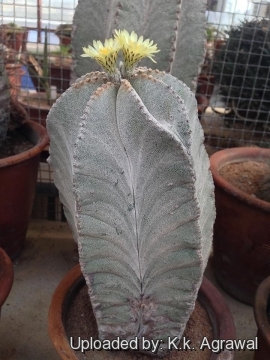
Cereus callicoche (Astrophytum myriostigma) Photo by: K.k. Agrawal
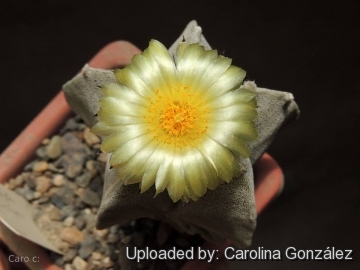
Cereus callicoche (Astrophytum myriostigma) Photo by: Carolina González

The fruit of A. myriostigma (above) is very hairy, dehisces apically and has a greenish inner colour. (Astrophytum myriostigma) Photo by: Valentino Vallicelli
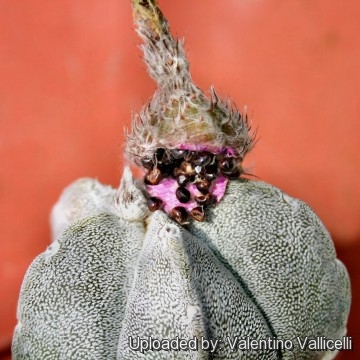
The fruit of A. coahuilense it is very different, pinkish coloured and opens basally. (Astrophytum myriostigma) Photo by: Valentino Vallicelli
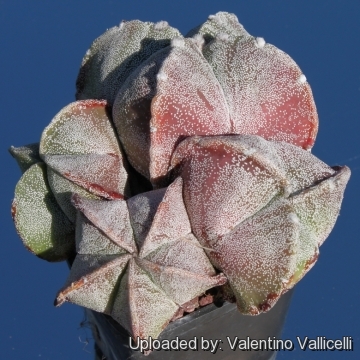
The ribs varies from 3 to (usually) 5 (Astrophytum myriostigma) Photo by: Valentino Vallicelli
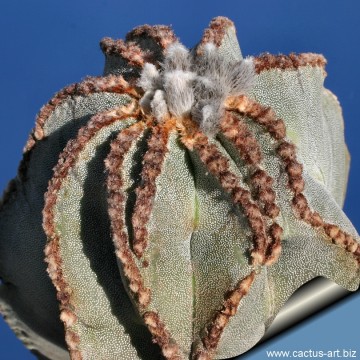
In older plants the areoles are large and woolly, often brownish/reddish,but also white/yellowish to tan/black. (Astrophytum myriostigma) Photo by: Cactus Art
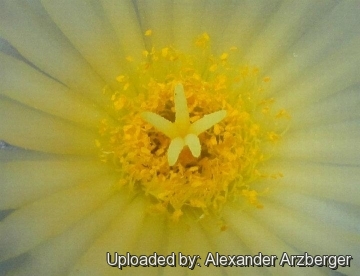
Cereus callicoche (Astrophytum myriostigma) Photo by: Alexander Arzberger
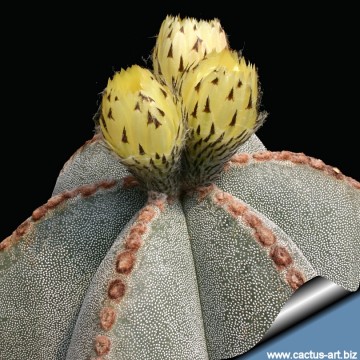
Cereus callicoche (Astrophytum myriostigma) Photo by: Cactus Art
Cultivation and Propagation: Astrophytum myriostigmaSN|1845]]SN|1845]] is a summer grower species relatively easy to grow. It is sometime seen as a grafted plant but grows very well on its own roots too.
Growth rate: It is a slow growing and easily flowering species.
Soil: Use mineral well permeable substratum with little organic matter (peat, humus), plants may become too elongated if compost is too rich.
Repotting: Re-pot every 2 years. Use pot with good drainage.
Fertilization: It grows much faster with a low nitrogen content fertilizer in spring and summer. Potassium helps maintaining the plants compact and healthy.
Watering: Requires careful watering to keep plant compact. Water sparingly from March till October, the thin, fibrous roots suffer if there is humidity, therefore the plant should be watered only when the surrounding terrain is dry. Keep dry as soon as the temperature starts dropping in October and keep it perfectly dry in winter at temperatures from 5 to 15 degrees centigrade.
Hardiness: They need to be kept in a cool place during winter rest and are somewhat resistant to frost if kept on the dry side prior to, and during, cold weather (due to the altitude they are hardy to -5 C ° C, or less for short periods). Although it is one of the easier Astrophytum to grow, it tends to rot in winter during the resting phase, if kept wet. In the rest period no high atmospheric humidity!!
Sun Exposure: Light shade to full sun, its colour tends to richer and darker when grown in light shade.
Uses: It is an excellent plant for container growing. It always looks good and stays small.
Pests & diseases: It may be attractive to a variety of insects, but plants in good condition should be nearly pest-free, particularly if they are grown in a mineral potting-mix, with good exposure and ventilation. Nonetheless, there are several pests to watch for:
- Red spiders: Red spiders may be effectively rubbed up by watering the infested plants from above.
- Mealy bugs: Mealy bugs occasionally develop aerial into the new growth among the wool with disfiguring results, but the worst types develop underground on the roots and are invisible except by their effects.
- Scales: Scales are rarely a problem.
- Rot: Rot is only a minor problem with cacti if the plants are watered and “aired” correctly. If they are not, fungicides won't help all that much. To prevent rottenness it is also advisable to surround its root neck by very rough sand or grit, this help a fast water drainage.
Propagation: Almost exclusively by seed. Plants are sometimes grafted onto column-shaped cacti. Cutting scions from a flourishing plant is almost a crime because the scions do not root easily.
Remarks: This quite variable plant has been widely grown for years and is now available in several cultivated variety and several breeds do exist. The famouse “Onzuka” is only one of these and though maybe the most beautiful, but a lot of other forms are represented in many collections.
| Your Actions | |
|---|---|
| Back to Cereus index | |
| Back to Cactaceae index | |
 |
Back to Cacti Encyclopedia index |
Privacy stantement - Terms and conditions - How to cite - About us - Feedback - Donate






